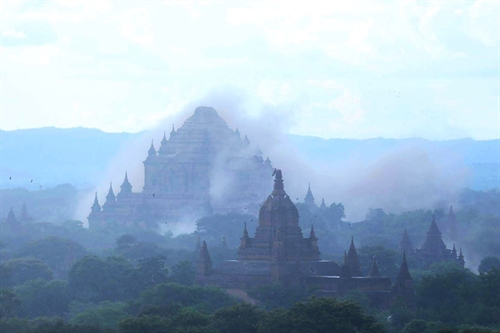 World
World

Myanmar took stock of toppled spires and crumbling temple walls in the ancient capital Bagan today after a powerful earthquake hit the country, killing three and damaging the top tourist destination.
 |
| The ancient Sulamani temple is seen shrouded in dust as a 6.8 magnitude earthquake hit Bagan on August 24. — AFP/VNA Photo |
BAGAN, Myanmar — Myanmar took stock of toppled spires and crumbling temple walls in the ancient capital Bagan today after a powerful earthquake hit the country, killing three and damaging the top tourist destination.
Two young girls and a man died in Magway region where the 6.8 magnitude quake struck yesterday evening, cracking buildings across centre of the country and sending tremors that were felt as far away as Bangkok and Kolkata.
In nearby Bagan, home to a vast plain of some 2,500 Buddhist monuments that are among Myanmar’s most venerated religious sites, teams of government-dispatched engineers and architects surveyed damage to nearly 200 of the prized pagodas.
"First we need to figure out the extent of the damage," Arkar Kyaw, the deputy director of Myanmar’s culture ministry said.
"Then we will make a renovation plan," he said, adding that the government is working directly with UNESCO.
First estimates showed at least 185 pagodas at Bagan were damaged, as security officers blocked tourists from entering temples while workers cleared piles of bricks, swept the grounds and sorted through fragments of murals.
"I heard sounds after I paid homage at a pagoda. There were foreign tourists there as well," said Khin Maung Toe, a Myanmar man who was visiting Bagan for the first time when the earthquake struck.
"My wife barely escaped outside as the pagoda collapsed," he said.
The temples, many of which are around 1,000 years old, are a top attraction for tourists flocking to Myanmar as it emerges from decades of military rule.
Bagan’s sweeping expanse of temple ruins - which make for a staggering sunset vista -- have survived wars, earthquakes and centuries of tropical sun.
In its heyday, between the 9th and 13th centuries, the city was the capital of a powerful kingdom and one of Asia’s most important centres for learning.
"It’s really heartbreaking. I cannot even eat," said Tin Hla Oo, a trustee of the three-story Htilominlo pagoda, which was badly damaged by the quake.
"We are suffering because this is a great loss, as these (pagodas) are priceless." — AFP




